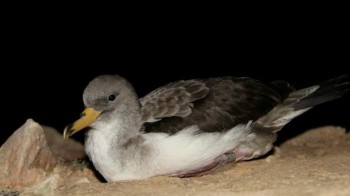Georgios Karris (Department of Environmental Technology, Technological Educational Institute of Ionian Islands, Panagoula, Zakynthos, Greece) and colleagues have published on fishery discards taken by Scopoli’s Shearwaters Calonectris diomedea (Least Concern) in the eastern Mediterranean in the light of proposed Common Fishery Policy reforms in the open-access journal Avian Research.
The paper’s long abstract follows:
“Background
The banning of fisheries discards by imposing an obligation to land unwanted catch constitutes a key point of the Common Fishery Policy reform proposed by the European Commission. The effect of such a ban on discards on top marine predators such as seabirds is largely unknown, especially in oligotrophic systems of the Mediterranean. The current study investigates the presence of scavenging seabirds around fishing trawlers as well as the exploitation of discards produced by bottom trawlers in the eastern Ionian Sea.
Methods
On-board observations were randomly conducted in May and December 2014, in order to record the presence and use of fishery discards by two common seabird species, namely, Scopoli’s Shearwater (Calonectris diomedea) and the Yellow-legged Gull (Larus michahellis).
Results
A total of 3400 seabirds were counted during May of which 2190 individuals were Scopoli’s Shearwaters and 1210 were Yellow-legged Gulls. The latter species was the only scavenger observed during winter and in total, 768 individuals were counted. Differences in species abundance in the study area are related to breeding phenology and migratory movements. The number of seabirds attending bottom trawler operations during morning and afternoon hours showed no significant differences for both seabird species. Both scavenging seabirds extensively exploited fishery discards, which were mainly demersal fish, and consumed 70–80% of the total fishery discards biomass; however, they appeared to avoid poisonous species and/or large-sized fish. Yellow-legged Gulls displayed kleptoparasitic behaviour on Scopoli’s Shearwater during feeding experiments. The number of such incidents depended on the number of gulls around the fishing vessel, with more than 90% success rates.
Conclusions
Considering the average annual biomass of discards estimations and the consumption rate found in this work, 106.1–117.9 t may be offered as a food subsidy to scavenging seabirds in the study area and should support a substantial part of local populations. Our results constitute baseline information on the annual amount of fishery discards and their exploitation rate by seabirds in the Ionian Sea, and suggest further work for a complete understanding of the potential impacts of the discards reform bill on seabirds.”

Scopoli's Shearwater, photograph by Benjamin Metzger
Reference:
Karris, G., Ketsilis-Rinis, V.,Kalogeropoulou, A., Xirouchakis, S., Machias, A., Maina, I. & Kavadas, S. 2018. The use of demersal trawling discards as a food source for two scavenging seabird species: a case study of an eastern Mediterranean oligotrophic marine ecosystem. Avian Research https://doi.org/10.1186/s40657-018-0118-5.
John Cooper, ACAP Information Officer, 19 October 2018

 English
English  Français
Français  Español
Español